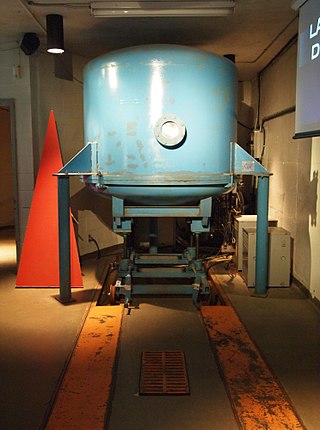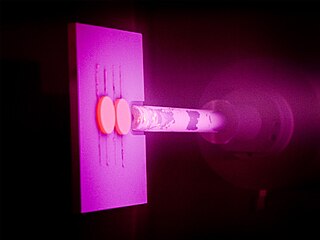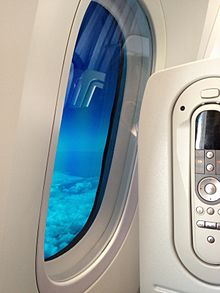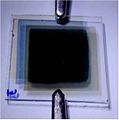Indium tin oxide (ITO) is a ternary composition of indium, tin and oxygen in varying proportions. Depending on the oxygen content, it can be described as either a ceramic or an alloy. Indium tin oxide is typically encountered as an oxygen-saturated composition with a formulation of 74% In, 8% Sn, and 18% O by weight. Oxygen-saturated compositions are so typical that unsaturated compositions are termed oxygen-deficient ITO. It is transparent and colorless in thin layers, while in bulk form it is yellowish to gray. In the infrared region of the spectrum it acts as a metal-like mirror,

The vertical-cavity surface-emitting laser is a type of semiconductor laser diode with laser beam emission perpendicular from the top surface, contrary to conventional edge-emitting semiconductor lasers which emit from surfaces formed by cleaving the individual chip out of a wafer. VCSELs are used in various laser products, including computer mice, fiber optic communications, laser printers, Face ID, and smartglasses.

An optical coating is one or more thin layers of material deposited on an optical component such as a lens, prism or mirror, which alters the way in which the optic reflects and transmits light. These coatings have become a key technology in the field of optics. One type of optical coating is an anti-reflective coating, which reduces unwanted reflections from surfaces, and is commonly used on spectacle and camera lenses. Another type is the high-reflector coating, which can be used to produce mirrors that reflect greater than 99.99% of the light that falls on them. More complex optical coatings exhibit high reflection over some range of wavelengths, and anti-reflection over another range, allowing the production of dichroic thin-film filters.

Smart glass, also known as switchable glass, dynamic glass, and smart-tinting glass, is a type of glass that can change its reflective properties to prevent sunlight and heat from entering a building and to also provide privacy. Smart glass for building aims to provide more energy-efficient buildings by reducing the amount of solar heat that passes through glass windows.
In chemistry, chromism is a process that induces a change, often reversible, in the colors of compounds. In most cases, chromism is based on a change in the electron states of molecules, especially the π- or d-electron state, so this phenomenon is induced by various external stimuli which can alter the electron density of substances. It is known that there are many natural compounds that have chromism, and many artificial compounds with specific chromism have been synthesized to date. It is usually synonymous with chromotropism, the (reversible) change in color of a substance due to the physical and chemical properties of its ambient surrounding medium, such as temperature and pressure, light, solvent, and presence of ions and electrons.

Tungsten(VI) oxide, also known as tungsten trioxide is a chemical compound of oxygen and the transition metal tungsten, with formula WO3. The compound is also called tungstic anhydride, reflecting its relation to tungstic acid H2WO4. It is a light yellow crystalline solid.

Electrochromism is a phenomenon in which a material displays changes in color or opacity in response to an electrical stimulus. In this way, a smart window made of an electrochromic material can block specific wavelengths of ultraviolet, visible or (near) infrared light. The ability to control the transmittance of near-infrared light can increase the energy efficiency of a building, reducing the amount of energy needed to cool during summer and heat during winter.

An antireflective, antiglare or anti-reflection (AR) coating is a type of optical coating applied to the surface of lenses, other optical elements, and photovoltaic cells to reduce reflection. In typical imaging systems, this improves the efficiency since less light is lost due to reflection. In complex systems such as cameras, binoculars, telescopes, and microscopes the reduction in reflections also improves the contrast of the image by elimination of stray light. This is especially important in planetary astronomy. In other applications, the primary benefit is the elimination of the reflection itself, such as a coating on eyeglass lenses that makes the eyes of the wearer more visible to others, or a coating to reduce the glint from a covert viewer's binoculars or telescopic sight.
Chalcogenide glass is a glass containing one or more chalcogens. Up until recently, chalcogenide glasses (ChGs) were believed to be predominantly covalently bonded materials and classified as covalent network solids. A most recent and extremely comprehensive university study of more than 265 different ChG elemental compositions, representing 40 different elemental families now shows that the vast majority of chalcogenide glasses are more accurately defined as being predominantly bonded by the weaker van der Waals forces of atomic physics and more accurately classified as van der Waals network solids. They are not exclusively bonded by these weaker vdW forces, and do exhibit varying percentages of covalency, based upon their specific chemical makeup. Polonium is also a chalcogen but is not used because of its strong radioactivity. Chalcogenide materials behave rather differently from oxides, in particular their lower band gaps contribute to very dissimilar optical and electrical properties.
Silvering is the chemical process of coating a non-conductive substrate such as glass with a reflective substance, to produce a mirror. While the metal is often silver, the term is used for the application of any reflective metal.
Gentex Corporation is an American electronics and technology company that develops, designs and manufactures automatic-dimming rear-view mirrors, camera-based driver assistance systems, and other equipment for the global automotive industry. They produce dimmable aircraft windows for the commercial, business and general aviation markets. In addition, the company produces photoelectric smoke detectors, signaling devices, and the HomeLink Wireless Control System for the North American fire protection market.

An optical fiber, or optical fibre in Commonwealth English, is a flexible glass or plastic fiber that can transmit light from one end to the other. Such fibers find wide usage in fiber-optic communications, where they permit transmission over longer distances and at higher bandwidths than electrical cables. Fibers are used instead of metal wires because signals travel along them with less loss; in addition, fibers are immune to electromagnetic interference, a problem from which metal wires suffer. Fibers are also used for illumination and imaging, and are often wrapped in bundles so they may be used to carry light into, or images out of confined spaces, as in the case of a fiberscope. Specially designed fibers are also used for a variety of other applications, such as fiber optic sensors and fiber lasers.

Vanadium(IV) oxide or vanadium dioxide is an inorganic compound with the formula VO2. It is a dark blue solid. Vanadium(IV) dioxide is amphoteric, dissolving in non-oxidising acids to give the blue vanadyl ion, [VO]2+ and in alkali to give the brown [V4O9]2− ion, or at high pH [VO4]4−. VO2 has a phase transition very close to room temperature (~68 °C (341 K)). Electrical resistivity, opacity, etc, can change up several orders. Owing to these properties, it has been used in surface coating, sensors, and imaging. Potential applications include use in memory devices, phase-change switches, passive radiative cooling applications, such as smart windows and roofs, that cool or warm depending on temperature, aerospace communication systems and neuromorphic computing.

Vacuum deposition is a group of processes used to deposit layers of material atom-by-atom or molecule-by-molecule on a solid surface. These processes operate at pressures well below atmospheric pressure. The deposited layers can range from a thickness of one atom up to millimeters, forming freestanding structures. Multiple layers of different materials can be used, for example to form optical coatings. The process can be qualified based on the vapor source; physical vapor deposition uses a liquid or solid source and chemical vapor deposition uses a chemical vapor.

Physical vapor deposition (PVD), sometimes called physical vapor transport (PVT), describes a variety of vacuum deposition methods which can be used to produce thin films and coatings on substrates including metals, ceramics, glass, and polymers. PVD is characterized by a process in which the material transitions from a condensed phase to a vapor phase and then back to a thin film condensed phase. The most common PVD processes are sputtering and evaporation. PVD is used in the manufacturing of items which require thin films for optical, mechanical, electrical, acoustic or chemical functions. Examples include semiconductor devices such as thin-film solar cells, microelectromechanical devices such as thin film bulk acoustic resonator, aluminized PET film for food packaging and balloons, and titanium nitride coated cutting tools for metalworking. Besides PVD tools for fabrication, special smaller tools used mainly for scientific purposes have been developed.

Solid-state ionics is the study of ionic-electronic mixed conductor and fully ionic conductors and their uses. Some materials that fall into this category include inorganic crystalline and polycrystalline solids, ceramics, glasses, polymers, and composites. Solid-state ionic devices, such as solid oxide fuel cells, can be much more reliable and long-lasting, especially under harsh conditions, than comparable devices with fluid electrolytes.
Gasochromism is closely related to electrochromism. The process involves the interaction of an electrochrome, usually a metal oxide, such as tungsten oxide, with an oxidizing or reducing gas, commonly oxygen and hydrogen, producing reversible color changes. The gasochromic technology is used commercially in reversible smart windows and gas sensing of oxygen, hydrogen, nitric oxide, hydrogen sulphide and carbon monoxide.

SAGE Electrochromics, Inc., a wholly owned subsidiary of Saint-Gobain, is a specialized window glass developer based in Faribault, Minnesota.

Claes-Göran Sture Granqvist is a materials physicist and Professor of Solid State Physics at Uppsala University in Sweden. Granqvist is considered a pioneer and expert in photochromic materials and energy-efficient building materials such as glass, paint, and wood.

Smart inorganic polymers (SIPs) are hybrid or fully inorganic polymers with tunable (smart) properties such as stimuli responsive physical properties (shape, conductivity, rheology, bioactivity, self-repair, sensing etc.). While organic polymers are often petrol-based, the backbones of SIPs are made from elements other than carbon which can lessen the burden on scarce non-renewable resources and provide more sustainable alternatives. Common backbones utilized in SIPs include polysiloxanes, polyphosphates, and polyphosphazenes, to name a few.




















